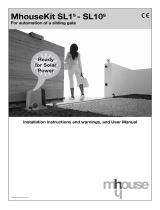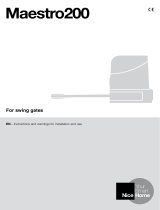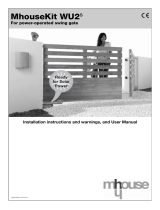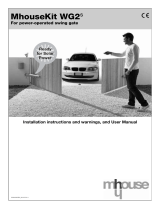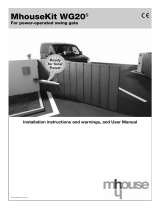Page is loading ...

-1-
ENGLISH
Warnings
- This manual is intended but for qualified technical staff and not for
end user. It is a task of the installer to inform afterwards user on the
use of the automatism and on possible dangers could come from it,
as well as on the need of a periodical maintenance.
- The set up is to be carried on only by qualified staff having got
required technical and professional requirements.
- The product is to be installed complying with rules in force about
computer-based closings.
- The device has been realised expressly to automate wing gates.
Any other employ is to be considered improper and therefore
forbidden.
- Always use original components.The manufacturer or supplier
doesn't take any responsibilityfor damages due to the use of unofficial
components.
- Before proceeding with set up, make sure the gate frame is solid
and fitted for the employ of the device.
- Before proceeding with set up, make sure that, during the gate
move, there are not friction points and that this one has no
possibilities to unhook from the pillar.
- Before acting on the device, check the power supply voltage is
disconnected.
- The equipment is not to be handled by children or incompetents.
- In case of lack of electric voltage, start the unblocking device to
manually open or close the gate.
- The maintenance of the device is to be executed but by qualified
staff authorized by the Manufacturer.
- Check the condition of the gate hinges any six months and lubricate
them when necessary.
Please read these instructions carefully before installing the
device as they contain important information concerning safety,
installation, use and maintenance.
- Use the device on respecting the technical limits described in the
following manual (see page 12).

-2-
ENGLISH
TECHNICAL CHARACTERISTICS
Gearmotor dimensions (mm)
TECHNICAL DATA STONE 180 STONE 24
Power supply 230 Vac - 50 Hz 24 Vdc
Nominal current 1,2 A 5,2 A
Electric power 1/3 HP 90 W
Maximum gate weight 350 Kg 250 Kg
Maximum gate length 2,5 mt 2,5 mt
Torque 330 Nm 270 Nm
Thermal protection 150 °C -
Operating temperature from -20 to +60°C from -20 to +60°C
Insulation degree IP67 IP67
Opening time 90° 15 Sec 15 Sec
Workingcycle 50% 90%
Weight 15 Kg 15 Kg
Fig.1
360
210,5
226
133,5

-3-
ENGLISH
Preliminary checks
Before installing STONE check the following points:
- Make sure that the device operates within its limits of employment
described in the technical characteristics table.
- Make sure that the gate structure is sturdy and that the wing moves
without frictions or other impediments.
- Make sure that the device is undamaged.
- Don’t install the product in explosive environments.
- Perform all the structural changes in order to ensure safety
distances and protect and segregate areas in which people may be
exposed to the risk of crushing, shearing, dragging or similar
dangers.
- Foresee a free area destined to the operations of maintenance and
unblocking.
- For anything not expressly specified in this handbook, follow the
norms in force.
- Each wing must have just one hinge, remove any extra ones.
- Don’t install the device on blank wing gates, functioning cannot be
guaranteed in the presence of strong wind.
- For complete safety, the mechanical stops with rubber cap (floor
stops) must be fitted in opening and closing of the wing. They
delimit the extreme points of opening and closing of the wing.
INSTALLATION
Fig.2
Foundation box dimensions (mm)
187 187
374
A
A
220
62
159
105
7
240
320

ENGLISH
Foundation box - Installation
- Dig a hole as per the measurements shown in fig.2. Foresee an
additional space for the pipes of water drainage and electric cables.
- Place the foundation box inside the hole so that the pin welded to
the box is aligned with the upper hinge of the gate (fig.3 and fig.4).
of water drainage- Insert the two pipes into the special holes fitted
on the box. Connect the pipes to a good canal of the rain
dispersion.
- Connect the tube of the electric cables into the special hole fitted on
the box, on the side of the wing opening.
- Cast the concrete inside the hole, making sure the box is level. It
must be 5 mm higher than the finished floor (cover thickness).
- Wait for the concrete has solidified.
-4-
Fig.3 Fig.4
Wing
Pillar

ENGLISH
Fig.5
Fig.6
- Let to pass the motor's cable
coming from the installation
through the special cable gland
Pg9, fitted on the motor's cover.
- Connect the cable coming from
the installation to the motor's
cable piece by means of clamps
(fig.5).
- Tighten the cable gland Pg9 and
connect the motor's cover to the
gearbox by means of the four screws.
- Anchor the gearmotor to the tie rods
of the foundation box with the
supplied bolts (fig.6).
Gearmotor - assembly instructions
After positioning the foundation box, assemble all the other
components:
- Insert the screw of chain stretcher
in the special bolt welded on the
foundation box and aligned to the
gearbox shaft (fig.7).
Fig.7
-5-

-6-
ENGLISH
Fig. 9
Fig. 8
- Connect the chain stretcher group to the
foundation box pivot (fig. 8).
- Insert the metal ball in the foundation
box pivot (fig. 9).
Fig. 10
- Put the traction arm on the foundation
box pivot (fig.10).
Fig. 11
- Join the chain connecting the traction
arm to the gearmotor by means of the
supplied link (fig.11).
Fig. 12
- Adjust the screw of chain stretcher
so that the chain is sufficiently tense
(fig.12).

-7-
ITALIANOENGLISH
Limit switches set up
Warning : for complete safety, the mechanical stops with rubber
cap (floor stops) must be fitted in opening and closing of the
gate in order to define the extreme points of the run.
Step-by-Step
- Connect the cable coming from the installation to the Limit switches
cable piece by means of heat shrinkable tubing (total insulation).
- Make sure that the gearmotor isn’t unlocked.
- Set up the “ ” operation mode on the electronic card.
- Start the gate run. As soon as the gate reaches the complete
opening, stop the gate by means of the remote control.
- With a screwdriver, move the magnet of the opening Limit switch
until the LED on the control unit goes off (fig. 13).
- Start the gate closing. As soon as the gate reaches the complete
closing, stop the gate by means of the remote control.
- With a screwdriver, move the magnet of the closing Limit switch
until the LED on the control unit goes off (fig. 13).
Fig. 13 Fig. 14
Magnet Limit switches

-8-
ENGLISH
- Place the foundation box cover on
the base (fig.15).
Tighten the supplied screws in order
to fasten the cover.
Fig. 16
Fig. 15
- Place the “ ” plate on the cover.
Tighten the two supplied screws in
order to fasten the plate (fig.16).
U
ELECTRIC CONNECTIONS
Warnings
- The gearmotor must be connected but to a control unit
manufactured by the company LEB.
- All connection operations must be performed without electric
voltage.
Power supply cable
- From the electric motor comes out four wires (230Vac - )
or two wires (24Vdc - STONE 24).
- In the following table the data concerning the power supply cable,
required for the connection to the control unit, are reported.
STONE 180

ITALIANOENGLISH
-9-
STONE 180
Cable 4x1,5 mm Color STONE 24
Cable 2x1,5 mm Color
Common Blue Positive motor Red or Green
Motor OPEN Black Negative motor Black or Brown
Motor CLOSE Brown
Ground Yellow-Green
Capacitor connection
- In the gearmotor STONE180 connect the 12uF capacitor between the
black wire (Open) and the brown wire (Close) of the electric engine.
Limit switches cable
The device is equipped with two magnetic Limit switches. From the
Limit switches block three wires come out. In the following table the
data concerning the Limit switches cable, required for the connection
to the control board, are reported.
Manual unblocking
The manual unblocking causes the release of the device
from the wing, allowing the manual displacement of this one. It can be
used in case of electric voltage lack or of installation failure. The
unblocking is made through a key that is to be kept by user in a sure and
easily reachable place. In order to obtain the unblocking of the device,
proceed in the following way:
- Insert the socket spanner into the hole fitted on the traction arm (fig.17).
- Turn the socket spanner in the direction indicated in fig.17, then open the
wing of the gate by hand.
- To lock, bring the wing back to the hooking position with the traction arm.
- Turn the socket spanner in the opposite direction and simultaneously
push the wing to hook it.
Cable 3 x 1,5 mm Colour
Common Blue
Limit switch OPENING Black
Limit switch CLOSING Brown

ENGLISH
Fig. 17 (Unblocking)
MAINTENANCE
Ordinary maintenance
N.B. :
Extraordinary maintenance
The owner should execute the following operations any time it is
required:
- Clean the area around the device.
- Clean and lubricate the hinges of the gate.
- Lubricate the unblocking group and the rotation pivot.
- Remove possible rubbles from the box and make sure that the
device has a good water drainage.
Six-monthly execute ordinary maintenance of the device.
Any operation of ordinary maintenance is to be performed by
qualified technical staff authorized by the Manufacturer.
- In the case hard interventions are required on the device, it is
advisable to remove this one, in order to allow the repairs in a
workshop by technicians of the Manufacturer or authorised by it.
-10-

TERMS AND LIMITS OF WARRANTY
1. The Electric Gate Shop gate kit is covered for 1 year, RTB. (Return to base) from
the date of purchase.
2. Warranty covers all components against faults arising from faulty manufacture,
materials, or factory workmanship.
3. The warranty only covers genuine component faults, and only applies when the
goods have been used in accordance with their specification. No warranty will be
given to any component where there has been misuse, abuse, damage or modification,
and will be rendered invalid if any repair is attempted without the approval of The
Electric Gate Shop LTD.
No warranty will be given to events of natural causes, ie. Lightening, flood, fire etc or
acts of vandalism. In addition it does not cover parts subject to wear (batteries, etc)
4. The liability of The Electric Gate Shop LTD will be limited to the cost of repair or
replacement of faulty components under warranty.
The cost of removing faulty components and returning them for warranty
consideration will be at the owners or installer’s expense.
5. In the event of a component failure you should contact The Electric Gate Shop
service support on 01226 370549 and arrange for the item to be repaired or replaced.
6. The Electric Gate Shop LTD reserves the right to ship faulty components to the
original manufacturer, for their test or repair before a decision on warranty is made.
Terms and limitations of component warranty are also liable to the terms and
conditions of the original manufacturer.

- 1 - UNAC Guide No. 2- July 2005
Installer:
(Name, address, telephone)
UNAC GUIDE No. 2
FOR THE MOTORISATION OF HINGED GATES
IN ACCORDANCE WITH MACHINERY DIRECTIVE 98/37/EEC AND THE APPLICABLE PARTS OF
STANDARDS EN 13241-1, EN 12453, EN 12445
With this publication UNAC sets out to inform and assist installers in applying the specifications of the directives
and of European standards concerning the safe use of motorised gates/doors.
It should be noted that those who sell and motorise an existing manual door/gate become the manufacturer of the
motorised door/gate machine and must prepare and keep the technical file, as laid down by Annex V of the
Machinery Directive (98/37/EEC). The technical file must contain the following documents:
Assembly drawing of the motorised door/gate (usually included in the installation manual).
Electrical connections and control circuit diagrams (usually included in the installation manual).
Risk analysis including (as indicated on the following pages):
the list of the essential requirements as indicated in Annex I of the Machinery Directive;
the list of the risks presented by the door/gate and the description of the solutions adopted.
They must also keep the manuals for installation and maintenance of the door/gate and of the components.
Prepare the operating instructions and general warnings for safety (if necessary integrating those in the manual
for installation of the door/gate) and give the user a copy.
Compile the proof book and give the user a copy (see facsimile in Annex 1).
Draft the EC declaration of conformity (see facsimile in Annex 2) and give the user a copy.
Fill in the label or plate with CE marking and attach it to the motorised door/gate.
N.B. The technical file must be held and made available to the competent national authorities for at least ten years
from the date of construction of the motorised door/gate.
Note also that, as from May 2005, the manufacturer of a new door/gate (both manual and motorised) must observe the
procedure for the CE marking pursuant to the Construction Products Directive (89/106/EEC), as indicated in annex ZA of the
standard EN 13241-1. This procedure involves the manufacturer:
setting up and maintaining internal production control;
having a notified body carry out the initial type tests referring to the applicable characteristics indicated in Annex ZA of
standard EN 13241-1.
N.B. UNAC is preparing guidelines dedicated to the correct application of the Construction Products Directive (89/106/EEC).
Risk areas
of the hinged gate (Figure 1)
The information given was drafted and checked with the utmost care, nevertheless UNAC declines all responsibility for any errors, omissions or
inaccuracies due to technical or graphical requirements. UNAC points out that this guide does not replace the content of standards which the
manufacturer of the motorised door/gate must observe.

- 2 - UNAC Guide No. 2- July 2005
KEY TO THE MECHANICAL RISKS CAUSED BY MOVEMENT
Pursuant to the Machinery Directive:
“Danger zones” refer to any zone within and/or
around machinery in which an exposed person is
subject to a risk to his or her health and safety.
“Exposed person” refers to any person wholly or
partially in a danger zone.
MINIMUM LEVEL OF PROTECTION OF THE MAIN EDGE
Type of use Type of actuation
controls Informed users
(private area)
Informed users
(public area)
Uninformed users
Hold-to-run control Pushbutton control Pushbutton control with key Hold-to-run control not
possible
Impulse control with door
visible
Limitation of forces, or
presence sensing devices
Limitation of forces, or
presence sensing devices
Limitation of forces and
photocells, or presence
sensing devices
Impulse control with door
not visible
Limitation of forces, or
presence sensing devices
Limitation of forces and
photocells, or presence
sensing devices
Limitation of forces and
photocells, or presence
sensing devices
Automatic control (e.g.
timed closure control)
Limitation of forces and
photocells, or presence
sensing devices
Limitation of forces and
photocells, or presence
sensing devices
Limitation or forces and
photocells, or presence
sensing devices
ANALYSIS OF THE RISKS AND CHOICE OF SOLUTIONS
IN ACCORDANCE WITH THE MACHINERY DIRECTIVE 98/37/EEC AND THE STANDARDS EN 13241-1, EN
12453, EN 12445
The risks listed below follow the sequence of the installation process. These risks are those which are commonly
present in motorised doors/gates systems. According to the various situations, consideration therefore has to be
made of any possible additional risks and exclude those which are not applicable. The solutions to be adopted are
those indicated by the standards mentioned above; in the case of risks not dealt with, the safety integration
principles indicated by the Machinery Directive (Annex 1 – 1.1.2) have to be applied.
MD
Ann. 1
Type of risks
Evaluation criteria and solutions to be adopted
(Tick the box corresponding to the solution adopted)
1.3.1
1.3.2
1.5.15
Mechanical, structural and
wear risks.
[1] Loss of stability and
break-up.
[2] Tripping.
F Check the solidity of the structure installed (jambs, hinges and leaves) in
relation to the forces generated by the motor.
Attach the motor stably using adequate materials.
If available, check the content of the EC declaration of conformity of the
manual gate.
F If necessary, carry out the structural calculation and attach it to the
Technical File.
F Check that the travel of the leaves is limited (during opening and closure)
by mechanical stops of adequate strength.
Check that the leaves cannot, under any circumstance, exit their slide guides
and fall.
F Check that any thresholds higher than 5 mm are visible, indicated or
shaped.
Im
p
act Crushin
g
Shearing Dragging
Cutting
Hookin
g

- 3 - UNAC Guide No. 2- July 2005
MD
Ann. 1
Type of risks
Evaluation criteria and solutions to be adopted
(Tick the box corresponding to the solution adopted)
1.3.7
1.3.8
1.4
Mechanical risks caused by the movement of the gate (see references in Figure 1).
F CAUTION – If the door/gate is used solely with hold-to-run controls (and meets the requirements of the
standard EN 12453), the danger points listed below do not have to be protected.
F CAUTION – If protective devices are installed (in accordance with the standard EN 12978) which prevent in
all cases contact between the moving leaf and persons (for example photoelectric barriers, presence sensing
devices), it is not necessary to measure the operating forces.
[3] Impact and crushing on the main closing
edge (Figure 1, risk A).
F Measure the closure forces (by means of the
special instrument required by the standard EN
12445) as illustrated.
In the case of gates with two leaves, the closure
force should be measured one leaf at a time.
Check that the values measured by the instrument
are below those indicated in the graph.
Carry out the measurements in the following points:
L = 50, 300 and 500 mm;
H = 50 mm,
at mid-height of the leaf and
at the height of the leaf minus 300 mm (max
2500).
N.B. The measurement should be repeated three
times in each point and the average value
considered.
The graph indicates the maximum values of the
dynamic, static and residual operating forces in
relation to the various positions of the leaf.
N. B. With reference to the measurement points with
L = 50, 300 and 500 mm, the maximum dynamic
force value permitted is 400 N.
F If the values of the forces are higher, install a
protective device in accordance with the standard
EN 12978 (for example a sensitive edge) and repeat
the measurement.
N. B. The dynamic force can be reduced, for
example, by reducing the speed of the leaf or using
a sensitive edge with high elastic deformation.
Leaves with overlapping and delayed closure
Leaves with simultaneous closure
Force
Dynamic force
IMPACT
Static force
CRUSHING
time
Protective Device Protective Device

- 4 - UNAC Guide No. 2- July 2005
MD
Ann. 1
Type of risks considered Evaluation criteria and solutions to be adopted
(Tick the box corresponding to the solution adopted)
[4] Impact and crushing in the area of opening (Figure 1, risk B).
F Observe the safety distances illustrated (in the most prominent part of the leaf).
or:
F Measure the forces of opening (by means of the
special instrument required by the standard EN
12445) as illustrated.
Check that the values measured by the instrument are
less than those indicated in the graph above.
Carry out the measurement at a height of 1000 mm
(or in the most prominent point of the leaf
N.B. The measurement should be repeated three
times and the average value considered.
F If the values of the forces are higher, install a
protective device in accordance with the standard EN
12978 (for example a sensitive edge) and repeat the
measurement.
[5] Impact in the area of closure (Figure 1, risk C).
F Install a pair of photocells (recommended height
500 mm) so as to sense the presence of the test
parallelepiped (height 700 mm) positioned as
illustrated.
N.B. The test specimen for presence sensing is a
parallelepiped (700 x 300 x 200 mm) with 3 faces with
a light and reflective surface and 3 faces with a dark
and opaque surface.
[6] Impact in the area of opening (Figure 1, risk B)
and in the area of closure (Figure 1, risk C)
F To reduce further the possibility of impact in the
areas of movement of the gate, it is possible to install
a pair of photocells (recommended height 500 mm) so
as to sense the presence of the test parallelepiped
(height 700 mm) positioned as illustrated.
Moto
r
Photocell
Specimen for
presence sensing
Photocell Photocell
Photocell
Photocell Photocell
Specimen for
sensing presence

- 5 - UNAC Guide No. 2- July 2005
MD
Ann. 1
Type of risks
Evaluation criteria and solutions to be adopted
(Tick the box corresponding to the solution adopted)
1.3.7
1.3.8
1.4
Mechanical risks due to
movement of the leaf.
[7] Dragging of the
hands on the hinges side
edge (Figure 1, risk D).
[8] Dragging of the feet
on the lower edge
(Figure 1, risk E).
[9] Dragging of the
hands on the drive unit
(Figure 1, risk F).
[10] Dragging, hooking
and cutting due to the
shaping of the mobile
leaf (Figure 1, risk G).
F Check that there is a clearance > 25 mm,
or:
F attach guards that prevent fingers from being inserted (for example a
rubber strip).
F The clearance between the gate and ground must prevent the risk of
dragging of the feet.
N.B. Should, due to the slope of the ground, the clearance vary, guards
should be attached (e.g. rubber strips).
F If the distances between the drive unit and the leaf vary, check on the
presence of a clearance > 25 mm, or attach guards (e.g. covers or strips in
rubber).
F Eliminate or protect any sharp edges, handles, projecting parts etc. (for
example by means of covers or strips in rubber).
1.5.1
1.5.2
1.5.10
1.5.11
Electrical and electromagnetic
compatibility risks
[11] Direct and indirect
contacts.
Dispersion of electrical
energy.
[12] Risks relating to
electromagnetic
compatibility.
F Use CE-marked components and materials pursuant to the Low Voltage
Directive (73/23/EEC).
F Carry out the electrical connections, connection to the mains, earth
connections and relevant checks, in accordance with current regulations and
as indicated in the installation manual of the drive unit.
N.B. If the electrical supply line is already set up (via both a socket and a
connector block), declarations of conformity to Italian law no. 46/90 are not
necessary.
F Use CE-marked components pursuant to the EMC Directive (89/336/EEC).
Carry out the installation as indicated in the manual for installation of the drive
unit.
1.2
1.5.3
1.2.3
1.2.4
Safety and reliability of
drive unit and control and
safety devices.
[13] Safety conditions in
the event of
malfunctioning and
power failure.
[14] Energy types other
than electrical energy
[15] Actuation and
disabling of the drive
unit.
[16] Power supply
switch.
F Use drive units which comply with the standard EN 12453 and safety
devices which comply with the standard EN 12978.
F If hydraulic drive units are used, they must comply with the standard EN
982; or
F if pneumatic drive units are used, they must comply with the standard EN
983.
F Check that, after a fault or power failure, the drive unit restarts safely
without creating hazardous situations.
F Install an omnipolar switch for electrical insulation of the door/gate, in
accordance with current laws. This switch must be positioned and protected
against accidental or unauthorised actuation.

- 6 - UNAC Guide No. 2- July 2005
MD
Ann. 1
Type of risks
Evaluation criteria and solutions to be adopted
(Tick the box corresponding to the solution adopted)
1.2.5
1.5.14
1.2.4
[17] Consistency of
controls
[18] Risk of trapping.
[19] Emergency stop.
F Install the controls (e.g. key selector) so that the user is not in a danger
zone, and check that the meaning of the controls has been understood by the
user (for example the function selector).
F Use CE-marked radio controls pursuant to the R&TTE directive
(1999/5/EEC) and complying with the frequencies admitted by the laws of
each individual country.
F Install a device for release of the drive unit that allows manual opening and
closure of the leaf with force no higher than 225 N (for doors/gates in
residential areas) or 390 N (for doors/gates in industrial or commercial areas).
Supply the user with the means and instructions for the release operations.
Check that operation of the release device is simple and does not create
additional risks.
F If appropriate, install an emergency stop control in accordance with the
standard EN 418.
N.B. Make sure that the emergency stop does not introduce additional risks,
aborting operation of the safety devices installed.
1.7.1
1.7.2
1.7.3
1.7.4
1.6.1
1.1.2
Integration principles for
safety and information.
[20] Signalling
equipment.
[21] Warnings.
[22] Marking.
[23] Operating
instructions.
[23] Maintenance.
[24] Unprotected residual
risks.
F A flashing light should be installed, in a visible position, to indicate
movement of the leaf.
F Traffic lights can be installed to control vehicle traffic.
F Reflectors can also be attached to the leaf.
F Attach all those signs or warnings considered necessary for indicating any
unprotected residual risks and to indicate any foreseeable improper use.
F Attach the label or plate with the CE marking and containing at least what
is shown in the illustration.
F Consign to the user the operating instructions, safety warnings and EC
declaration of conformity (cf. facsimile in Annex 2).
F A maintenance plan has to be drawn up and implemented.
Check on the proper working of the safety devices at least every 6 months.
FRecord the work carried out in the proof book in accordance with the
standard EN 12635 (cf. facsimile in Annex 1).
F Inform the user in writing (for example in the operating instructions) of any
unprotected residual risks and foreseeable improper use.
Manufacturer (name – address): _____________
Type of gate: _____________________________
Identification number: _____________________
Year of manufacture: ______________________
Automatic Gate
/



